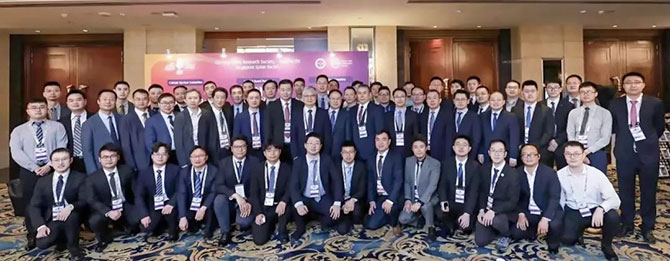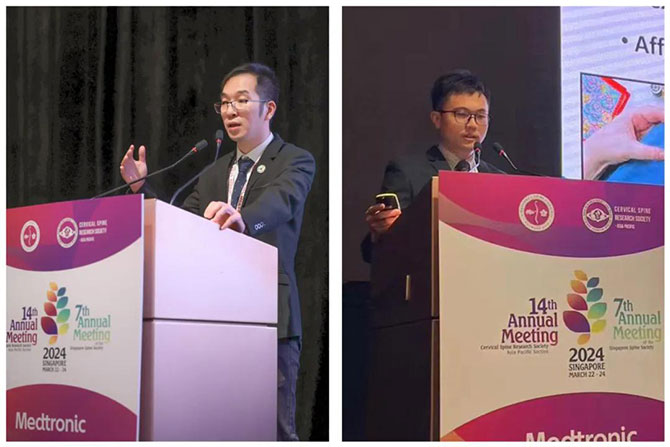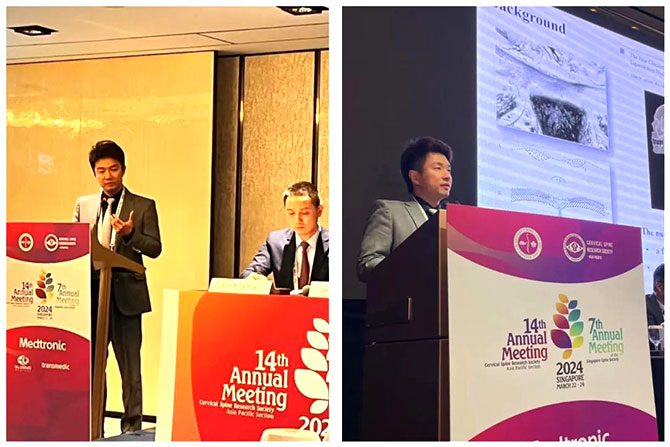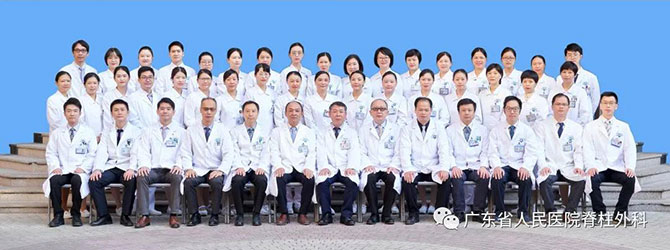

On March 22, 2024, the 14th Annual Meeting of Cervical Spine Research Society - Asia Pacific (CSRS-AP) was held in Singapore, where top international experts in cervical spine surgery gathered to discuss the latest advancements in the field. This academic event was fully live-streamed online. Led by Chief Dr. Chang Yunbing, the cervical spine disease research team presented 5 research achievements on this international stage, showcasing the clinical and research strength of the Department of Spine Surgery at Guangdong Provincial People’s Hospital through online presentations and poster displays.

The Cervical Spine Research Society - Asia Pacific (CSRS-AP) is an internationally recognized academic exchange platform in the field of cervical spine surgery. The Society aims to share and discuss the latest technological and research advancements in cervical spine surgery on an international scale.

At the meeting, Dr. Liang Guoyan and Dr. Ye Yongyu from the Department of Spine Surgery of Guangdong Provincial People’s Hospital proposed new concepts based on the 10-second grasp test. Dr. Liang Guoyan pointed out that the test can be used to grade the severity of hand flexibility in patients with degenerative cervical myelopathy. His research indicates that when patients have fewer than or equal to 13 grasps within 10 seconds, their hand function is severely impaired, suggesting the need for surgical intervention. This simple test can be widely used for screening cervical spine diseases. Dr. Ye Yongyu further introduced the team’s early development of a deep learning-enhanced 10-second grasp test assessment tool. By ensuring diagnostic accuracy, the grasp time was shortened to 6 seconds, which further validates the feasibility and usability of the grasp test and enhances user-friendliness.

During the presentation, Dr. Chen Chong shared 2 latest findings regarding anterior cervical discectomy and fusion (ACDF) surgeries and 1 research outcome concerning the pathophysiological mechanism of ligamentum flavum ossification. Through cervical spine CT reconstructions, he found that the autologous bone group exhibited a higher early fusion rate compared to the allograft bone group in ACDF surgeries, with no significant difference in long-term fusion rates. Further investigation into the three-dimensional morphological features of the cervical spine revealed that the majority of autologous in situ bone mass met the grafting requirements for ACDF surgeries, potentially reducing the use of allogeneic bone and thus lowering treatment costs, which carries clinical significance. Additionally, he analyzed ossification of the ligamentum flavum at different levels, discovering that ossification was more mature in the mid-sections with lighter inflammatory reactions. Furthermore, he noted differences in the expression levels of cytokines involved in inducing ossification and promoting bone maturation between different levels.
Chief Dr. Chang Yunbing and Dr. Liang Guoyan are Active Members of CSRS-AP, while Dr. Chen Chong is the Associated Member of CSRS-AP within the spine research team. They have been actively participating in major international academic exchange platforms in the field of cervical spine, showcasing the significant academic contributions of the Department of Spine Surgery of Guangdong Provincial People’s Hospital and highlighting their standing in the international academic community.
The Department of Spine Surgery of Guangdong Provincial People’s Hospital serves as the Deputy Leading Unit of the Spine Microsurgery Group under the Chinese Medical Doctor Association and the Training Base for Microsurgery and Minimally Invasive Surgery of the China College of Orthopedic Surgeons (CCOS). With nearly 20 years of experience in performing a wide range of microscopic spine surgeries, it stands as a leading institution in the field of spine microsurgery in South China. In recent years, the Department has been dedicated to promoting microsurgical techniques in spine surgery, with uninterrupted efforts even during the COVID-19 pandemic. Since 2020, Over 10 online lectures and live-streaming surgeries have been hosted. Furthermore, the Department has been at the forefront of utilizing various endoscopic techniques, including lumbar posterior endoscopic, lumbar lateral endoscopic, thoracic endoscopic decompression, and cervical Keyhole surgery, for the past decade. The groundbreaking work in being the first in China to perform dual-channel endoscopic surgery in early 2020 has established it as the preferred surgical approach for treating degenerative lumbar conditions such as lumbar disc herniation, lumbar spinal stenosis, lumbar spondylolisthesis, and lumbar facet joint cysts. The Department stands as one of the leading institutions in China in terms of the volume of dual-channel endoscopic lumbar fusion surgeries performed.

Spine Surgery Team
Department of Spine Surgery
Updated: March 29, 2024